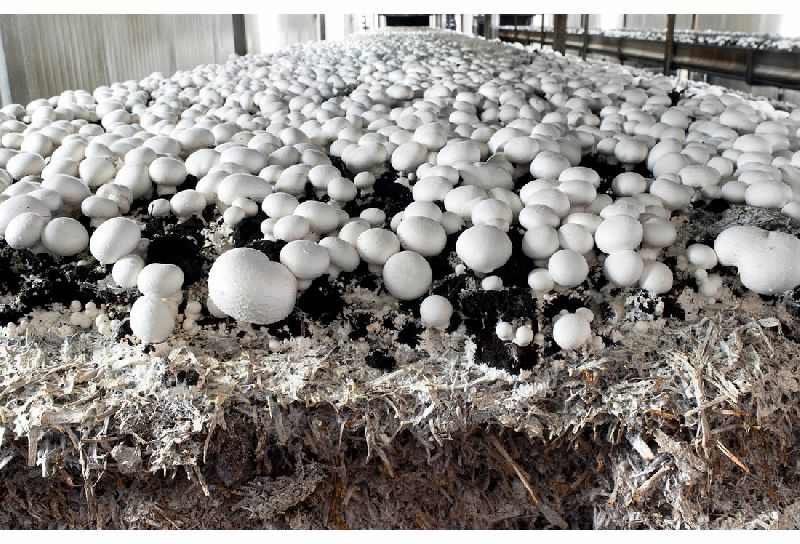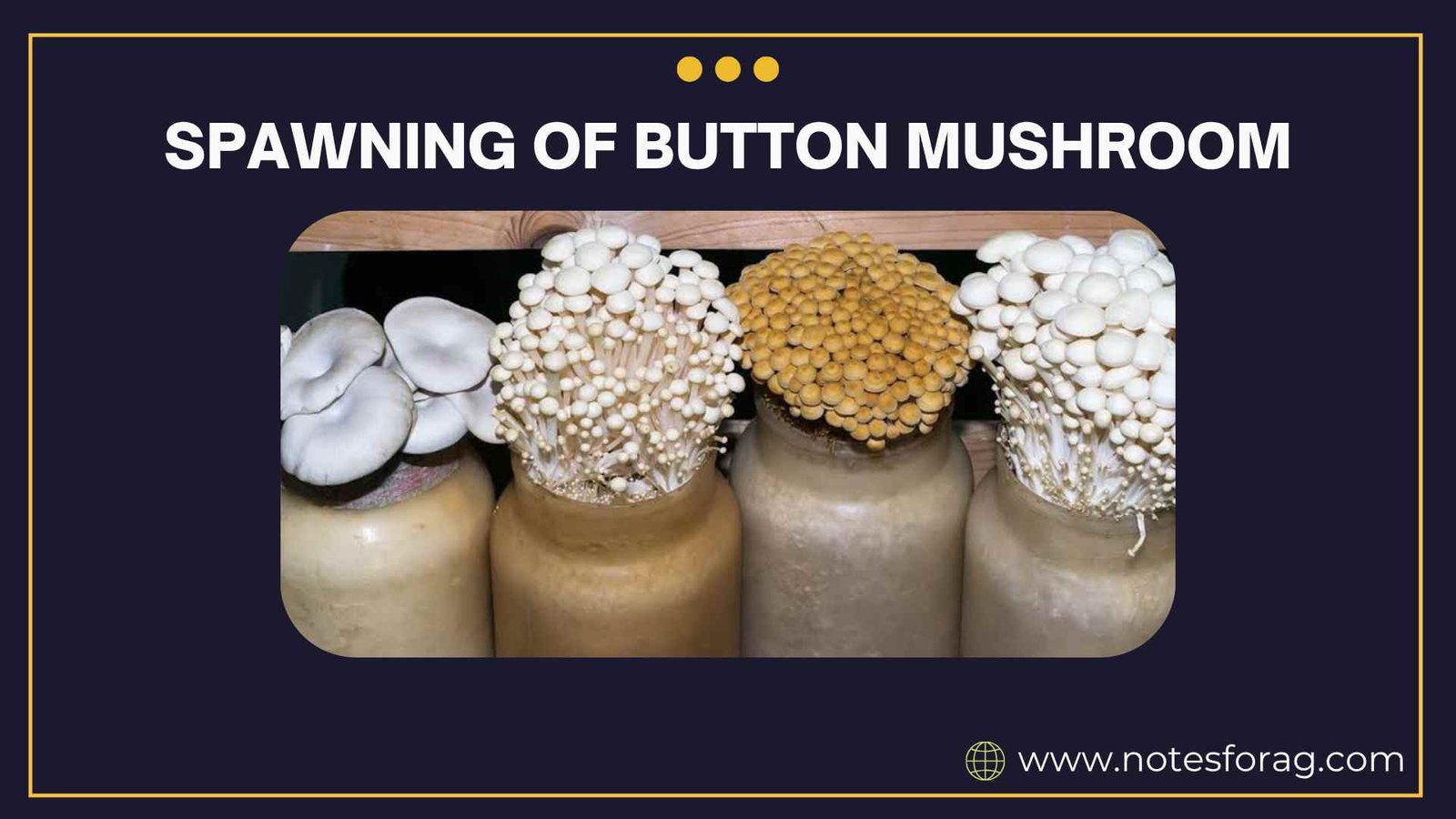1. Introduction

The process spawning in button mushroom cultivation is one of the most important stages for ensuring a good yield and healthy mushroom growth. Spawning refers to the introduction of mushroom mycelium (the vegetative part of the fungus) into the growing medium, usually compost. This is the step where the foundation is laid for successful mushroom production. Understanding the methods, timing, and precautions during spawning can greatly influence the overall productivity and quality of button mushrooms.
2. What is Spawning?

Spawning is the process of planting mushroom spawn (which is mycelium grown on a carrier material like grains or sawdust) into a prepared substrate. In button mushroom cultivation, the spawn is typically introduced into a specially prepared compost that provides all the nutrients required for the mycelium to grow and spread.
Summary of Spawning in button mushroom
- Spawning begins by mixing high-quality spawn into properly pasteurized compost, laying the foundation for strong and uniform mycelial growth.
- During the spawn running phase, maintaining optimal humidity (90–95%) and temperature (24–26 °C) for 12–14 days ensures full colonization of the compost.
- After colonization, a moist and porous casing layer (3–5 cm thick, pH 7–7.5) is applied, followed by precise environmental adjustments to trigger pinning and healthy mushroom development.
Table of Contents
3. Types of Spawn Used in button mushroom Cultivation

3.1 Grain Spawn
Grain spawn is the most commonly used type of spawn in button mushroom cultivation. It involves colonizing cereal grains like wheat, rye, or millet with mushroom mycelium. Grain spawn is easy to handle, spreads quickly in the compost, and gives a high yield due to better mycelial growth.
3.2 Brick Spawn
Brick spawn, also known as block spawn, consists of compacted mycelium grown on organic matter like straw or farm waste. It is less common now due to slower colonization rates compared to grain spawn.
3.3 Liquid Spawn
Liquid spawn is a suspension of mycelium in a nutrient-rich solution. It can be injected into the compost and ensures even distribution. However, it requires more technical expertise and sterile conditions.
3.4 Sawdust Spawn
This type of spawn uses sawdust as the carrier material for the mycelium. Though more commonly used in wood-loving mushrooms, it can be adapted for button mushrooms under certain conditions.
4. Stages of Spawning in button mushroom cultivation
The Stages of Spawning in Button mushroom cultivation are,
4.1 Preparation of Compost
Before spawning, compost must be properly prepared and pasteurized. Compost provides the nutrients necessary for mycelial growth. It should have the right balance of carbon and nitrogen, proper moisture content (65-70%), and a pH around 7.
4.2 Pasteurization of Compost
Pasteurization is done to kill harmful pathogens and pests in the compost. This is typically done by steam treatment at 58-60°C for 6-8 hours. Once pasteurization is complete, the compost is cooled to the desired spawning temperature.
4.3 Spawning Process
Spawning is usually done when the compost temperature is between 22°C to 26°C. The spawn is mixed into the compost either by hand or mechanically. The compost is then filled into trays, bags, or beds depending on the farming system.
5. Types of Spawning in button mushroom techniques
The types of spawning in button mushroom techniques,
5.1 Surface Spawning
In surface spawning, the spawn is spread on top of the compost layer and then lightly mixed or covered with a thin layer of compost. This is useful in small-scale setups and ensures better oxygen availability to the mycelium.
5.2 Through Spawning
Through spawning involves mixing the spawn uniformly throughout the compost. This method results in faster colonization and is preferred in commercial cultivation.
5.3 Layer Spawning
This involves adding spawn in layers as the compost is filled into beds or trays. For example, compost is added in 3-4 layers and spawn is spread between each layer.
6. Post Care for Spawning in button Mushroom
The Post Care for Spawning in button Mushroom are,
6.1 Incubation or Spawn Running
After spawning, the compost is kept in a dark room with a temperature of around 24-26°C and humidity of 90-95%. This stage is called spawn running, and it lasts for 12-14 days. During this period, the mycelium spreads throughout the compost.
6.2 Monitoring Conditions
The conditions during spawn running must be carefully monitored. High humidity, optimal temperature, and limited disturbance are key. Proper ventilation is also important to prevent CO2 accumulation.
7. Common Problems During Spawning in button mushroom
7.1 Contamination
One of the biggest challenges is contamination from bacteria, molds, or other fungi. This can be caused by poor hygiene, unsterilized compost, or contaminated spawn.
7.2 Slow Mycelium Growth
This can be due to poor-quality spawn, incorrect compost preparation, or unfavorable environmental conditions like low temperature or high ammonia levels.
7.3 Overheating
If compost temperature is too high during spawning, it can kill the mycelium. Proper temperature control and aeration are essential.
8. Improving Spawn Efficiency
8.1 Use of Quality Spawn
Always use certified, high-quality spawn with good viability and strain performance. This increases colonization speed and ensures better yield.
8.2 Proper Compost Management
Ensure the compost is well-prepared, well-aerated, and properly pasteurized. Balanced nutrients and moisture content are crucial.
8.3 Hygienic Practices
Maintain cleanliness during spawning and throughout the cultivation period. Disinfect tools, trays, and hands to avoid contamination.
8.4 Optimal Environmental Conditions
Monitor and control temperature, humidity, and air exchange to create favorable conditions for mycelial growth.
9. Innovations of Spawning in button mushroom
9.1 Mechanized Spawning Equipment
Large-scale farms now use automated spawning machines that ensure uniform mixing of spawn and compost, saving time and labor.
9.2 Pre-colonized Compost Blocks
Some growers now use pre-colonized compost blocks where spawn running is already done. This reduces the spawn run time and enhances uniformity.
9.3 Biological Enhancers
Biostimulants and growth enhancers like beneficial bacteria or nutrients are added to compost or spawn to improve mycelial vigor.
10. Conclusion
Spawning is a critical step in button mushroom cultivation that lays the foundation for successful crop growth. It involves the careful introduction of mycelium into a nutrient-rich, pasteurized compost under sterile and controlled conditions. The choice of spawn type, the method of spawning, and the environmental factors during the spawn run all contribute significantly to the yield and quality of mushrooms. While traditional methods like grain spawning and through spawning remain popular, modern innovations like mechanized spawning and biological enhancers are making cultivation more efficient and productive. With proper compost preparation, quality spawn, and good hygiene practices, growers can ensure a healthy start for their mushroom crop, leading to bountiful harvests.
Frequently Asked Questions (FAQs)
How much spawn should I use per kg of compost?
You should use around 0.5% to 0.75% of spawn by the weight of the compost. This means for every 100 kg of compost, you’ll need about 0.5 to 0.75 kg of mushroom spawn. Using this amount helps the mycelium (the root-like part of mushrooms) spread properly through the compost. It also prevents the compost from getting too hot, which can happen if you use too much spawn. A correct spawn rate ensures healthy growth and a better mushroom yield.
What temperature is best for spawn running?
The ideal temperature for spawn running is between 24°C and 26°C. Spawn running is the stage where the mycelium grows and spreads all over the compost. This process takes about 12 to 14 days. If the temperature is too low, the growth will be slow. If it’s too high, the mycelium may die. So, keeping the temperature just right helps the mycelium grow fast and healthy, leading to better mushroom production later.
What is casing soil and why is it important?
Casing soil is a special layer of moist, porous soil (about 3–5 cm thick) that is added on top of the compost after the mycelium has fully spread. It usually has a neutral pH of 7–7.5. The casing layer holds moisture, provides fresh air, and creates the right environment for pinning the stage when small mushrooms start to form. Without a good casing layer, mushroom growth can be uneven or weak. It plays a key role in triggering mushroom formation.
How much humidity do button mushrooms require at the pinning stage?
During the pinning and fruiting stages, button mushrooms need a high level of humidity about 85% to 90%. This keeps the casing layer moist and prevents the tiny mushrooms (pins) from drying out. Proper humidity also helps the mushrooms grow big and healthy. If the air is too dry, the mushrooms can become small, cracked, or stop growing. So, keeping enough moisture in the air is very important for a good harvest.
Related Articles

